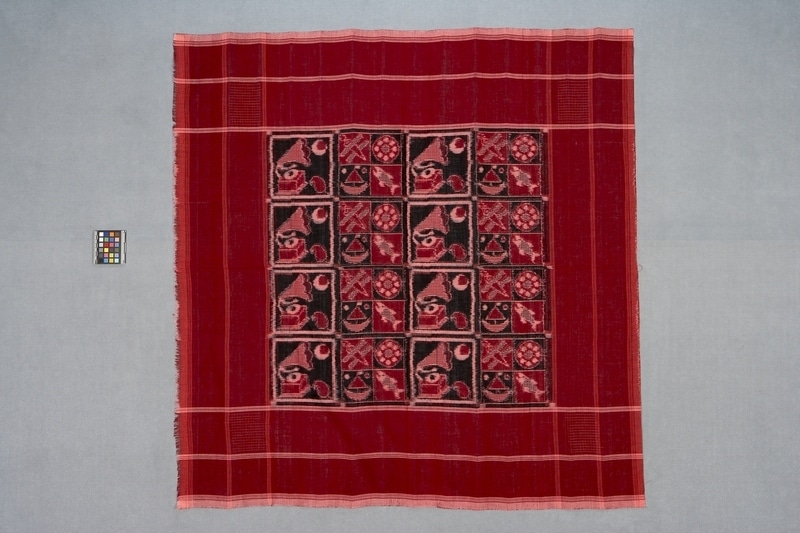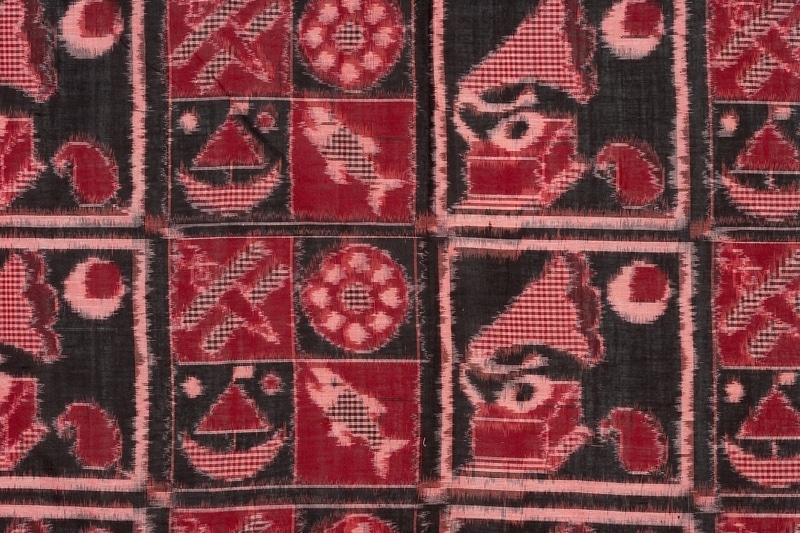Turban Cloth Item Number: 2737/3 from the MOA: University of British Columbia


Description
Double-ikat rumal. Dark reddish purple, pink and black cloth. Long rectangular area in the centre has images of phonographs, biplanes, sailboats, fish and rotary phones woven into it, in squares.
History Of Use
This cloth comes from the famous dying and weaving villages along the coast of the State of Andhra Pradesh in South India. It is called a “telia rumal” (or literally “oil handkerchief”) in reference to the oily dyes used in its manufacture. It is of a type of work that has for centuries been exported from the SE coast of India to West Africa for use in wedding and other ceremonies among groups there. Although made as a turban in its local context, such cloths are used in Africa to make special ritual enclosures and canopies. The colours of these cloths are always red black and white and the extraordinary and now rarely produced double ikat design in this case includes phonographs, biplanes, sailboats, fish and rotary telephone dials. The archaic patterns have also survived in the repertoire of the artist.
Narrative
Purchased by the collector at the DakshinaChitra museum (related to the Madras Craft Foundation) in Muttukadu, near Chennai.
Specific Techniques
Double ikat dye technique used in weaving; madder root used for red dye; black also a vegetable dye.
Item History
- Made by Lakshmipathy Gajam (Maker) in Puttapakka, Andhra Pradesh, India during 2008
- Collected in Muttukadu, Tamil Nadu, India
- Owned by Stephen Inglis before April 22, 2009
- Received from Stephen Inglis (Seller) and Museum of Anthropology Acquisitions Budget (Funding source) on April 22, 2009
What
- Name
- Turban Cloth
- Identification Number
- 2737/3
- Type of Item
- cloth
- Material
- cotton fibre and dye
- Overall
- height 117.0 cm, width 114.0 cm
Who
- Culture
- South India
- Creator
- Lakshmipathy Gajam (Maker)
- Previous Owner
- Stephen Inglis
- Received from
- Stephen Inglis (Seller) and Museum of Anthropology Acquisitions Budget (Funding source)
Where
- Holding Institution
- MOA: University of British Columbia
- Made in
- Puttapakka, Andhra Pradesh, India
- Collected in
- Muttukadu, Tamil Nadu, India
When
- Creation Date
- during 2008
- Ownership Date
- before April 22, 2009
- Acquisition Date
- on April 22, 2009
Other
- Item Classes
- textiles
- Condition
- good
- Current Location
- Case 103
- Accession Number
- 2737/0003